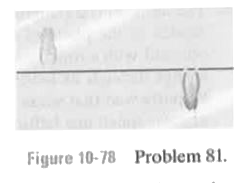Two skaters each of mass 50kg, approach each other along parallel paths separated by 3m. They have equal ad opposite velocities of 10m/s. The first skater carries a long light pole, 3m long, and the second skater grabs the end of it as he passes (assume frictionless ice).
a. Described quantitatively the motion of the skaters after they are connected by the pole.
b. By pulling on the skaters reduce their distance to 1m. What is their motion then?
c. Compare the KEs of the system in parts a. and b. where does the change come from?
Step by step video & image solution for Two skaters each of mass 50 kg, approach each other along parallel paths separated by 3m. They have equal ad opposite velocities of 10 m//s. The first skater carries a long light pole, 3 m long, and the second skater grabs the end of it as he passes (assume frictionless ice). a. Described quantitatively the motion of the skaters after they are connected by the pole. b. By pulling on the skaters reduce their distance to 1m. What is their motion then? c. Compare the KEs of the system in parts a. and b. where does the change come from? by Physics experts to help you in doubts & scoring excellent marks in Class 11 exams.
Topper's Solved these Questions
- BOOK - ANURAG MISHRACHAPTER - RIGID BODY MOTIONEXERCISE - SCQ_TYPE83videos
RIGID BODY MOTION
- BOOK - ANURAG MISHRACHAPTER - RIGID BODY MOTIONEXERCISE - MCQ_TYPE41videos
RIGID BODY MOTION
- BOOK - ANURAG MISHRACHAPTER - IMPULSE AND MOMENTUMEXERCISE - matching3videos
IMPULSE AND MOMENTUM
- BOOK - ANURAG MISHRACHAPTER - UNIT AND DIMENSIONSEXERCISE - Matching Type Problem4videos
UNIT AND DIMENSIONS
Similar Questions
In Fig. 10-78, two skaters, each of mass 50 kg, approach each other along parallel paths separated by 3.0 m. They have opposite velocities of 1.4 m/s each. One skater carries one end of a long pole of negligible mass, and the other skater grabs the other end as she passes. The skaters then rotate around the center of the pole. Assume that the friction between skates and ice is negligible. What are (a)the radius of the circle, (b) the angular speed of the skaters, and ( c) the kinetic energy of the two skater system? Next, the skaters pull along the pole unyil they are separated by 1.0 m. What then are (d) their angular speed and (e) the kinetic energy of the system? (f) What provided the energy for the increased kinetic energy?
 View Solution
View SolutionHow is a speed skater able to glide across the ice? How can the skater increase friction between the ice and the skates? What effect does an increase in friction have on the skater's speed ?
View Solution
Knowledge Check
- Question 1 - Select One
Two long parallel wires are separated by a distance of 2m. They carry a current of 1A each in opposite direction. The magnetic induction at the midpoint of a straight line connecting these two wires is
AzeroB2×10−7TC4×10−5TD4×10−7T - Question 2 - Select One
Two skaters A and B of mass 50 kg and 70 kg respectively stand facing each other 6 metres apart. They then pull on a light rope stretched between them. How far each moved when they meet?
ABoth have moved 3 metres.BA moves 2.5 metres and B moves 3.5 metres.CA moves 3.5 metrs and B moves 2.5 metres.DA moves 2 metres and B moves 4 metres. - Question 3 - Select One
Two skaters have weight in the ratio 4:5 and are 9m apart, on a smooth frictionless surface. They pull on a rope stretched between them. The ratio of the distance covered by them when they meet each other will be
A5:4B4:5C25:16D16:25
Two balls of masses 10 kg and 20 kg approach each other with velocities 30 m/s and 20 m/s respectively . Calculate their velocities after they undergo a perfectly eleastic collision .
View SolutionA skater wearing his skates is oushing a wall. What will be the work done by the contact force on the skater as he moves away from the wall?
View SolutionA train 50 m long passes a platform 100 m long in 10 seconds. The speed of the train in m/sec is -----
View SolutionTwo ice skaters A and B approach each other at right angles. Skater A has a mass 30 kg and velocity 1 m/s and skater B has a mass 20 kg and velocity 2 m/s. They meet and cling together. The final velocity of the couple is
View SolutionTwo trains A and B of length 100m and 200m, respectively, are approaching each other on parallel tracks. If they take 15s to pass each other and velocity of A is three that of B, find their velocities.
View Solution

